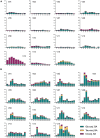Dynamics and determinants of human plasma bile acid profiles during dietary challenges
- PMID: 35967802
- PMCID: PMC9366195
- DOI: 10.3389/fnut.2022.932937
Dynamics and determinants of human plasma bile acid profiles during dietary challenges
Abstract
In recent years, bile acids (BA) have received great interest due to their pleiotropic biological activity and the presence of plasma membrane-bound and nuclear receptors. Moreover, BA in blood have been identified by metabolite screening approaches as biomarkers that are associated with various diseases and even with a human longevity phenotype. With the growing interest in the microbiota contribution to the health-disease trajectory, BA that undergo deconjugation and other modifications by bacteria in the large intestine have become a prime target as a microbiome diversity modifier. We here profiled BA by a quantitative and a semiquantitative approach in 15 healthy and phenotypically very similar young individuals for over a 36-h fasting period, an oral glucose tolerance test (OGTT), and an oral lipid tolerance test (OLTT). We demonstrate a remarkable heterogeneity of the responses and describe the different dynamics of the plasma changes that likely originate from different routes by which BA enters the peripheral blood, and that may represent a direct secretion from the liver into the blood and a route that reaches the blood as a spill-over after passing from the gallbladder through the intestine and the portal system. We discuss the finding that an individual transport process involved in the passage of BA could be a critical determinant in the kinetics of plasma appearance and the overall phenotypic variability found.
Keywords: OGTT; OLTT; bile salts; fasting; postprandial.
Copyright © 2022 Fiamoncini, Rist, Frommherz, Giesbertz, Pfrang, Kremer, Huber, Kastenmüller, Skurk, Hauner, Suhre, Daniel and Kulling.
Conflict of interest statement
The authors declare that the research was conducted in the absence of any commercial or financial relationships that could be construed as a potential conflict of interest.
Figures





Similar articles
-
Determinants of postprandial plasma bile acid kinetics in human volunteers.Am J Physiol Gastrointest Liver Physiol. 2017 Oct 1;313(4):G300-G312. doi: 10.1152/ajpgi.00157.2017. Epub 2017 Jun 29. Am J Physiol Gastrointest Liver Physiol. 2017. PMID: 28663304 Clinical Trial.
-
Metabolism of bile acids in the post-prandial state.Essays Biochem. 2016 Dec 15;60(5):409-418. doi: 10.1042/EBC20160052. Essays Biochem. 2016. PMID: 27980091 Review.
-
Short-term and divergent regulation of FGF-19 and FGF-21 during oral lipid tolerance test but not oral glucose tolerance test.Exp Clin Endocrinol Diabetes. 2015 Feb;123(2):88-94. doi: 10.1055/s-0034-1395635. Epub 2015 Feb 5. Exp Clin Endocrinol Diabetes. 2015. PMID: 25654672
-
Dynamic patterns of postprandial metabolic responses to three dietary challenges.Front Nutr. 2022 Sep 22;9:933526. doi: 10.3389/fnut.2022.933526. eCollection 2022. Front Nutr. 2022. PMID: 36211489 Free PMC article.
-
New insights into bacterial bile resistance mechanisms: the role of bile salt hydrolase and its impact on human health.Food Res Int. 2018 Oct;112:250-262. doi: 10.1016/j.foodres.2018.06.035. Epub 2018 Jun 20. Food Res Int. 2018. PMID: 30131136 Review.
Cited by
-
Lithocholic acid phenocopies anti-ageing effects of calorie restriction.Nature. 2025 Jul;643(8070):192-200. doi: 10.1038/s41586-024-08329-5. Epub 2024 Dec 18. Nature. 2025. PMID: 39695227 Free PMC article.
-
The Elevation and Impact of Peripheral Bile Acids in Chronic Lymphocytic Leukemia.Biomedicines. 2025 Apr 4;13(4):874. doi: 10.3390/biomedicines13040874. Biomedicines. 2025. PMID: 40299495 Free PMC article.
-
The Critical Role of the Bile Acid Receptor TGR5 in Energy Homeostasis: Insights into Physiology and Therapeutic Potential.Int J Mol Sci. 2025 Jul 8;26(14):6547. doi: 10.3390/ijms26146547. Int J Mol Sci. 2025. PMID: 40724796 Free PMC article. Review.
-
Probing erythrocytes as sensitive and reliable sensors of metabolic disturbances in the crosstalk between childhood obesity and insulin resistance: findings from an observational study, in vivo challenge tests, and ex vivo incubation assays.Cardiovasc Diabetol. 2024 Sep 11;23(1):336. doi: 10.1186/s12933-024-02395-9. Cardiovasc Diabetol. 2024. PMID: 39261864 Free PMC article.
References
LinkOut - more resources
Full Text Sources

